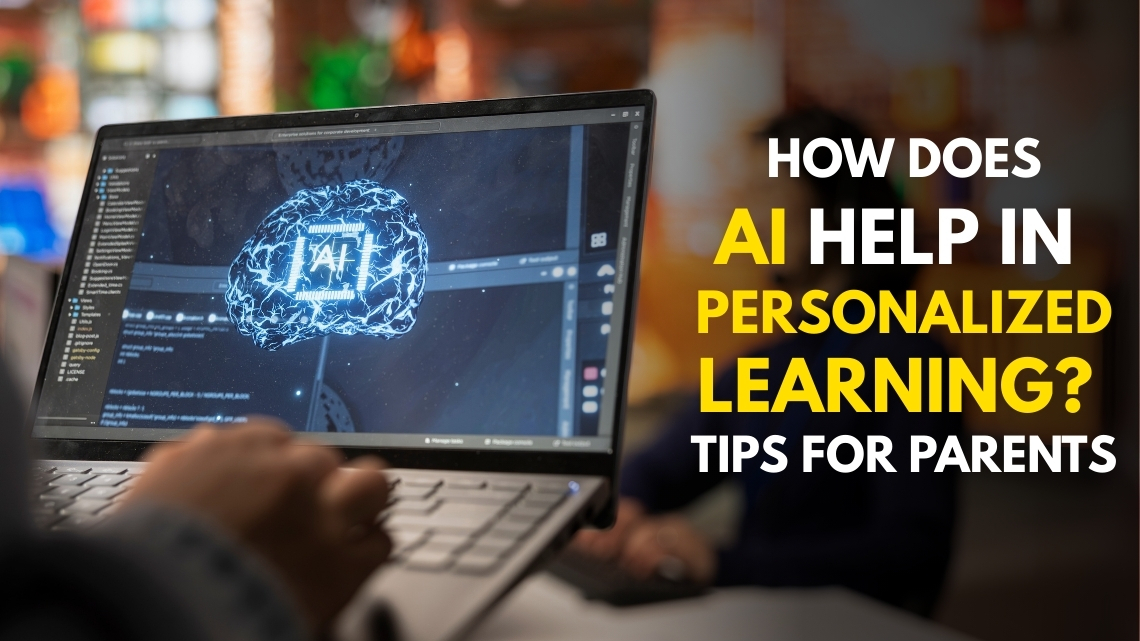
Personalized Learning with AI What Parents Should Know
How does AI help in Personalized Learning? Tips for Parents
Introduction
Artificial Intelligence has shaped the world in every drastic way possible, from creating ready-to-go websites to robots that serve you food. The world has seen it all, and in that big margin of development, there is also a part of education that lies in it.
Reducing paperwork and simplifying processes to offering personalised learning experiences, AI is transforming the way educators teach and students learn.
The use of artificial intelligence in Indian education is growing rapidly as it is shaping how students learn, how teachers teach, and how institutions run. In this blog, we will discuss how AI is helping students in their personalised learning.
What is Personalized Learning?
Personalized learning is an approach that helps students to experience their needs, interests, strengths, and pace individually through personal support. It uses customized lessons, adaptive technology, and flexible activities to provide instruction optimized for the individual learner.
Key Characteristics
Student-Centered: The focus shifts from teaching the whole
class to just teaching an individual child, as per their grasping ability.
Focuses on analytics: Data analytics are used to monitor
progress and provide personalized feedback to students.
Holistic Development: It emphasizes all aspects, such as
strengths, challenges, readiness, and learning preferences, to teach a child.
Development of Soft Skills: It encourages students to
develop crucial skills like self-direction, time management, and
problem-solving.
How AI Helps in Personalized Learning
Al helps the students to learn the things they want to learn in a way that keeps up with their pace, to make them curious about learning.
Progress Tracking: AI helps in tracking the progress og these students to get them ready for their next goal.
Identifies gaps: It helps us identify the gaps between what the students are learning and what they should be learning through Q&As and FAQs.
Suggests learning resources: AI also helps in suggesting resources like external books, YouTube videos, and games that help students to learn quickly.
Behaviour boost: AI gives you a confidence boost by asking questions at your level while increasing the toughness of questions, so that if you fail to answer, it could provide you with feedback on what you can do better and what you are good at.
Real-Life Applications for Children
In reading and language, AI tools can suggest books or articles suited to your child’s level and interests, while chatbots like ChatGPT can help them practice conversations or improve grammar and vocabulary in real time.
In math, adaptive apps create exercises that match your child’s skill level and explain solutions step by step, making problem-solving less frustrating and more fun. AI also supports coding and logical thinking, guiding children through projects like creating games or animations at their own pace.
For creative projects, AI can spark ideas for stories, poems, or art, helping children expand their imagination without replacing it. Even in science, AI can provide child-friendly explanations, virtual labs, or interactive experiments that encourage exploration beyond the textbook.
Tips for Parents to Support AI-Based Learning
1. Set Clear Goals
and Expectations
Help your child understand that AI is just a tool, not the answer to all their problems, and why they are using these tools instead of traditional methods (because it makes the process of learning easy).
Discuss with your child how long they can use these tools and for how long they have to study the traditional methods.
2. Monitor Progress
Without Micromanaging
Check on your child's learning, their strengths, and
weaknesses without making them feel uneasy.
Encourage them to share what they’ve learned or created with AI.
3. Encourage
Curiosity and Self-Directed Learning
Other than schoolwork, let children explore the ideas and topics of their interests using AI.
Support them in asking questions and finding answers independently.
4. Integrate AI With
Schoolwork, Not Replace It
Use AI to help with your schoolwork, but don’t replace it with the work that your child does in school.
Also, ensure that it uses the teacher's method rather than creating a new method of its own.
5. Safety and
Privacy Awareness
Teach children not to share personal information online.
Balance screen time with offline activities to maintain a healthy routine.
Benefits of Combining AI with School Learning
1. Reinforces the
School Curriculum
AI helps in solving the difficult problems that were not solved in the classroom. AI provides children with extra practice and explanations for topics they learn in school, which helps them make homework and revision much more effective.
2. Prepares Children
for Future Skills
Critical thinking, problem-solving, and digital literacy are also a part of a student's journey when they learn to use AI. It also familiarizes them with technology, which is one of the most important things for their future careers and jobs.
1. Encourages
Independent Learning Habits
AI empowers children to explore all the subjects they are interested in without any restrictions, at their own learning pace, which makes them feel independent, making them self-motivated and responsible.
2. Boosts Engagement
and Confidence
AI, with its playful way of learning, makes it engaging for children to study compared to the traditional method. By providing instant feedback, AI helps children understand their strengths and areas for improvement, providing them with confidence and courage to keep learning.
3. Supports Teachers
Without Replacing Them
It helps as a supplementary resource for teachers, helping them identify which areas a child may need more support in. It allows teachers to focus on personalized guidance and ensures that AI enhances the classroom experience rather than replacing human instruction.
Conclusion
Artificial Intelligence is no longer just a tool for industries—it has become a valuable companion in classrooms and homes. By making learning more personalized, interactive, and engaging, AI empowers children to understand concepts better and grow at their own pace. At the same time,
